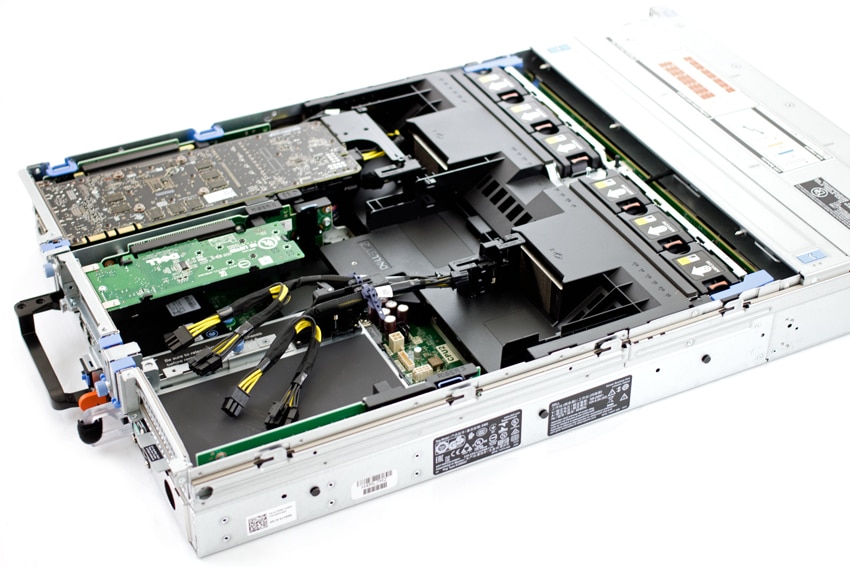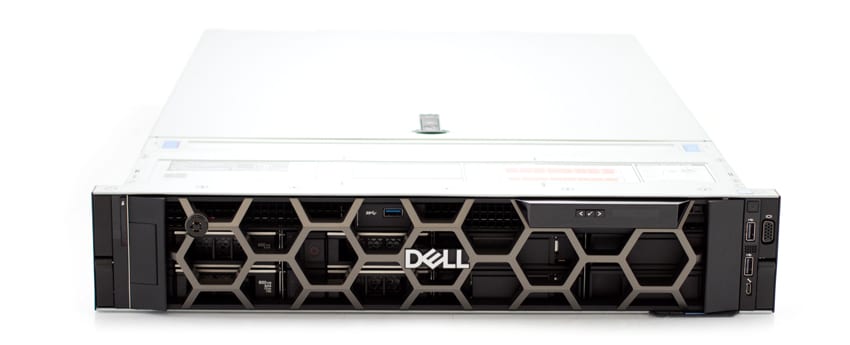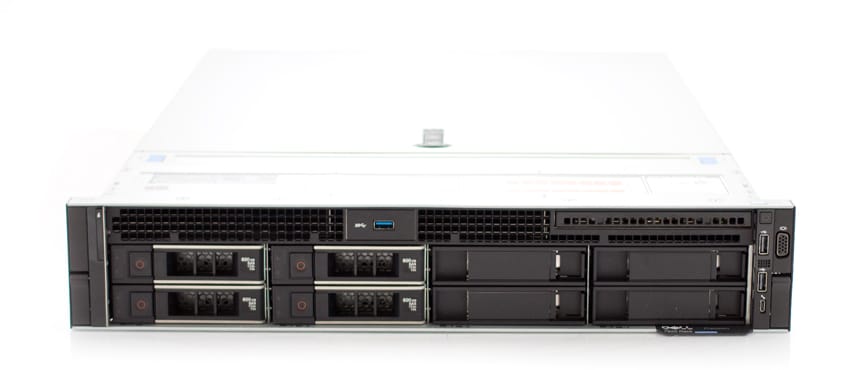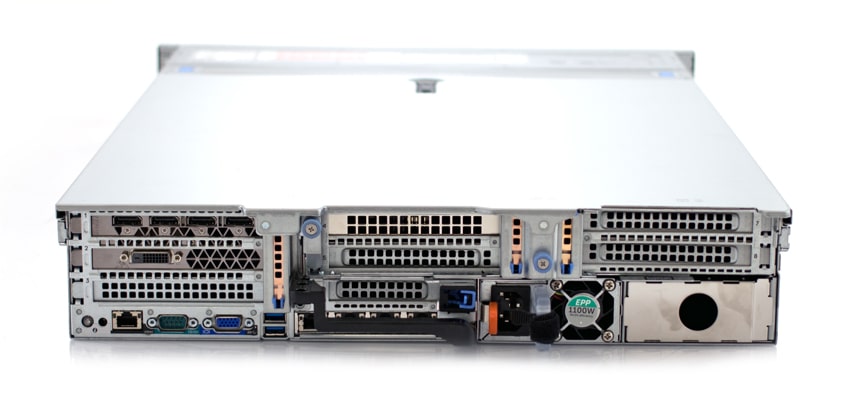![]() Dell’s Precision 7920 Rack is the company’s newest performance-driven, 2U-form-factor-desktop workstation designed for complex projects such as virtual-reality workflows. This powerful workstation provides datacenter protection, access to shared storage, IT management and control, security and more. It also features pretty much everything a server needs, including iDrac support (which allows admins to remotely deploy, update, monitor and maintain the Precision workstation seamlessly). Moreover, because the 7920 is of the 2U form factor, workers won’t have to deal with a noisy computer around their workspace, as the 7920 sits nicely tucked away in a server room among other rack devices.
Dell’s Precision 7920 Rack is the company’s newest performance-driven, 2U-form-factor-desktop workstation designed for complex projects such as virtual-reality workflows. This powerful workstation provides datacenter protection, access to shared storage, IT management and control, security and more. It also features pretty much everything a server needs, including iDrac support (which allows admins to remotely deploy, update, monitor and maintain the Precision workstation seamlessly). Moreover, because the 7920 is of the 2U form factor, workers won’t have to deal with a noisy computer around their workspace, as the 7920 sits nicely tucked away in a server room among other rack devices.
Dell’s Precision 7920 Rack is the company’s newest performance-driven, 2U-form-factor-desktop workstation designed for complex projects such as virtual-reality workflows. This powerful workstation provides datacenter protection, access to shared storage, IT management and control, security and more. It also features pretty much everything a server needs, including iDrac support (which allows admins to remotely deploy, update, monitor and maintain the Precision workstation seamlessly). Moreover, because the 7920 is of the 2U form factor, workers won’t have to deal with a noisy computer around their workspace, as the 7920 sits nicely tucked away in a server room among other rack devices.

Compared to the tower (desktop version), the Precision 7920 Rack is pretty much identical component-wise, with the only noticeable differences being the shape and more server-like features. Nonetheless, the 7920 Rack features the Intel Xeon Processor Scalable family, which can have up to 28 cores per processor, while system memory can be expanded to a whopping 3TB of 2666MHz when using specific processors. (As of this review, Dell notes that this feature isn’t available yet.) The performance-driven workstation can also be customized to feature some serious professional graphics power and up to 900W. This includes the next generation AMD Radeon Pro and NVIDIA Quadro lines. In addition, the 7920 supports up to 48TB of total storage via Enterprise-class SAS hard drives and Dell Precision Ultra-Speed drives with up to 8 M.2 PCIe NVMe SSDs.
Our configuration, which cost roughly $12,700, includes a Dual Intel Xeon Gold 6136 3.0GHz CPU, NVIDIA Quadro P5000 professional graphics card, 64GB of 2666MHz DDR4 RDIMM RAM, and a variety of different SSDs and HDDs.
Dell’s Precision 7920 Rack Specifications
- Processor Options:
- One or two Intel Xeon Processor Scalable Family CPUs with up to 28 cores per processor and Intel Advanced Vector Extensions, Intel Trusted Execution Technology, Intel AES New instructions, Optimized Intel Turbo Boost and optional Intel vPro technology
- Operating System:
- Windows 10 Pro for Workstations (up to 4 Cores)
- Windows 10 Pro for Workstations (4 Cores Plus)
- Windows 10 Pro for Workstations Downgrade to Windows 7 (up to 4 Cores)
- Windows 10 Pro for Workstations Downgrade to Windows 7 (4 Cores Plus)
- Red Hat Enterprise Linux 7.3
- Ubuntu Linux 16.04
- Suse Linux (SLES 12 SP2) supported
- NeoKylin 6.0 SP3 (China only)
- Chipset Intel: C621 (Lewisburg)
- Memory Options:
- Six channel memory up to 1.5TB 2666MHz DDR4 ECC memory with dual CPUs, up to 3TB with select CPU SKUs (future availability)
- 24 DIMM Slots (12 DIMMs per CPU). Note: memory speed is dependent on specific Intel Xeon Processors
- Scalable processor installed
- Graphics Options:
- Support for 3 PCI Express x16 Gen 3 graphics cards – up to 900W with 3 x 300W double-width graphics cards (dual CPU configuration) 1600W PSU recommended for maximum configurations and some restrictions apply
- High-end 3D cards:
- Radeon Pro WX 9100
- Radeon Pro SSG (future)
- NVIDIA Quadro GP100
- NVIDIA Quadro P6000
- NVIDIA Quadro P5000
- Mid-range 3D cards:
- Radeon Pro WX 7100
- Radeon Pro WX 5100
- NVIDIA Quadro P4000
- NVIDIA Quadro P2000
- Entry 3D cards:
- NVIDIA Quadro P600
- NVIDIA Quadro P400
- Integrated VGA graphics motherboard connector (part of iDRAC9 Systems Management and requires iDRAC9 Enterprise license to enable)
- Professional 2D cards: NVIDIA NVS 310
- Storage Options:
- Support for up to (8) 2.5” or 3.5” SATA/SAS drives, Up to 8 x M.2 NVMe PCIe SSDs via 2 x Dell UltraSpeed
- Drive Quad x16 cards (maximum requires dual CPUs), NVMe RAID 0,1,10 option on 1st card (Intel RSTe vROC).
- PERC PCIe controllers required for SAS drive support
- M.2 NVMe PCIe SSDs
- Up to 8* x 1TB drives on 2 Dell Precision Ultra-Speed Drive Quad x16 cards. *Requires dual CPU config.
- 2.5” SATA SSD
- Up to 8 x 1TB
- 2.5” SAS SSD
- Up to 8 x 800GB
- 2.5” SATA 7200 RPM
- Up to 8 x 2TB
- 3.5” SATA 7200 RPM
- Up to 8x 8TB (future)
- 2.5” SAS 10K RPM 12Gb/s
- Up to 8 x 1.8TB
- 2.5” SAS 15K RPM 12Gb/s
- Up to 8 x 600GB
- Storage Controller:
- Integrated: 2 x Intel chipset AHCI 6Gb/s SATA controllers with 4 ports (total 8) each for HDD/SSD. One port for optical drive
- Intel RSTe software RAID 0, 1,5,10 supported across 4 SATA ports on 1st controller only. (Maximum 4 drives in RAIDset)
- Intel RSTe (vROC) software RAID 0,1,10 option (motherboard activation key) for M.2 NVMe PCIe SSDs on 1st Dell Ultra-Speed Drive Quad x16 or Duo x8 card (0,1). Customer kit available for Intel RSTe (vROC) motherboard activation key for NVMe RAID support.
- Optional: PERC H330 12Gb/s SAS (6Gb/s SATA) 8 port PCIe controller supports JBOD and software
- RAID 0,1,5,10
- PERC H730P PCI-e SAS 12Gb/s (SATA 6Gb/s) Hardware RAID PCIe controller with 1GB cache (Super Cap backup, RAID 0/1/5/10 (no JBOD)
- PERC H740P PCI-e SAS 12Gb/s (SATA 6Gb/s) Hardware RAID PCIe controller with 4GB cache (Super Cap backup), RAID 0/1/5/10 (no JBOD)
- Note: Windows 7 is not supported on the PERC H740P controller. PERC controllers are installed in Slot 3
- Network Daughter Cards:
- Base: Intel i350-Quad port 1Gb Ethernet Network Daughter Card (4 x 1Gb ports),
- Optional: Intel® X550-Dual port 10Gb + Intel I350 Dual port 1Gb Ethernet Network Daughter card (2 x 10Gb + 2 x 1Gb ports)
- Intel® X710* Dual port 10Gb DA/SFP+, + I350 Dual port 1Gb Ethernet Network Daughter card
- Integrated: Integrated Broadcom® BCM54210 Ethernet LAN 10/100/1000 for iDRAC9 controller use with System Management tool suite
- 1:1 Remote Workstation Access Solutions:
- Optional: Teradici Dual and Quad display PCoIP PCIe remote access host cards
- Wyse 5030/7030 PCoIP Zero clients. Teradici PCoIP software clients for Windows, Mac, IOS, Android and ChromeOS available from Teradici
- Manageability:
- Dell OpenManage portfolio options that include Dell’s exclusive Integrated Dell Remote Access Controller (iDRAC) with Lifecycle Controller – includes one VGA graphics connection, Intel® vProTechnology’s advanced management features (optional, requires Intel WiFi® Link WLAN)
- Add-in cards:
- Optional: Dell Precision Ultra-Speed Drive Duo (HH/HL,x8 card) and Ultra-Speed Drive Quad (FH/FL,x16 card) with active cooling.
- Support for up to 2 and 4 M.2 NVMe PCIe SSDs respectively.
- USB 3.1 (Gen 2) 10Gb/s Type C card (2 ports) 1 DP pass-through port
- Optional: Dual & quad (FH card) display Teradici PCoIP PCIe remote workstation access cards. Full height and low profile bracket versions of dual display card available.
- Serial Port PCIe Card (single port)
- I/O Ports:
- Front:
- 1 – USB 2.0
- 1 – USB 2.0 Management port (IDRAC9)
- 1 – VGA Port for iDRAC9
- Internal:
- 1 – USB 3.1 Type A – supports standard USB storage key
- SD Vflash media connector
- Rear:
- 2 – USB 3.1 Type A
- 4 – RJ45 Network
- 1 – Serial
- 1 – RJ45 for iDRAC
- 1 – VGA Port for iDRAC
- Front:
- Chassis:
- HxWxD: 3.41” x 17.0” x 28.37” (29.78” with bezel); 86.8mm x 482mm x 715.5mm (751.3mm with bezel)
- Bays: (1) external slimline optical bay; (8) front accessible 3.5” bays (support total of (8) 3.5” or 2.5” HDD/SSD drives)
- Slots: All slots PCIe Gen 3. (6) PCIe full height/full length slots, (1) PCIe full height/half length slot, (1) PCIe low profile/full length slot
- Up to (3) double width x16 cards supported. All slots x16 mechanically.
- With single CPU – (1) x x16, (1) x x8, (1) x x8 half length, (1) x x8 low profile PCIe slots
- With dual CPUs (2) x x16, (2) x x8 PCIe slots
- Power Supply: One or two redundant hot pluggable 1100W –90% efficient (80PLUS Gold Certified), Available 1600W PSU is required for certain configurations
- HxWxD: 3.41” x 17.0” x 28.37” (29.78” with bezel); 86.8mm x 482mm x 715.5mm (751.3mm with bezel)
- Storage devices:
- Slimline options: DVD-ROM; DVD+/-RW BD-RE
- Security Options
- Trusted Platform Module (TPM 1.2 or TPM 2.0); chassis Intrusion switch; Setup/BIOS Password; I/O Interface Security; lockable front bezel, Dell Data Guardian, Dell Endpoint Security Suite Enterprise
- Warranty & Support Services: 3-Year Limited Hardware Warranty and 3-year NBD On-Site Service after Remote Diagnosis
- Optional: Dell ProSupport is designed to rapidly respond to your business’s needs, help protect your investment and sensitive data, and provide enhanced proactive support services to help reduce risk and complexity within your IT environment (check regional availability)
Design and Build
The Dell’s Precision 7920 is a 2U form factor rack that features 8 front-loaded bays that are neatly stacked along the bottom of the front panel. The front is also covered by a unique hexagon-shaped bezel that acts as a locking mechanism for the access to the drive bays, which can be opened with a key.

To the left of the drive bays are the System Status Indicator, System Health and System ID, and the iDRAC Quick Sync 2 wireless indicator. Front and center along the top is the USB 3.0 connector and then the optional optical-drive (Slimline DVD ROM SATA or Slimline DVD+/-RW SATA). To the right are two USB 2.0 connectors, the Power button (and Power LED), a VGA connector, and a USB management port/iDRAC Direct.

The majority of the Precision 7920 Rack’s back panel is taken up by the PCIe expansion card slots, which gives users the option to expand their Dell rack workstation with ultra-high performing Dell Ultra-Speed Drive Duo NVMe PCIe SSD Cards.
Along the bottom are the Power button/Power light, VGA connector, USB management port/iDRAC Direct and two USB 2.0 connectors. For network connection, users have the option of choosing an Intel X550 Quad Port Network Daughter Card (2x10GbE, 2x1Gbit), an Intel I350 (4x1Gbit) Quad Port Network Daughter Card (which comes standard and included in the base price), or an Intel X710 DP 10Gb DA/SFP+, + I350 DP 1Gb Ethernet, Network Daughter Card.

Removing the top panel gives access to interior components of the 7920 Rack. At the front is the hard-drive backplane, which is cooled by 6 fans. On top of the system board and to the right are the RAM DIMM sockets and CPUs. At the very back are the expansion card risers and VFlash connector.
As we indicated above, the Precision 7920 Rack offers a plethora of high-end graphics options from both AMD and NVIDIA. In our build, we populated the Dell rack workstation with the NVIDIA P5000 GPU professional graphics card, which features the company’s in-house Pascal GPU technology. Designed for those working with complex visual effects and simulations, larger rendering tasks, and VR experiences, this high-end card is capable of delivering some serious performance at just 180W and features 16GB of GDDR5 GPU memory and a native resolution at 7680 x 4320 @ 30 Hz with 30-bit color. Not only that, the P5000 also supports the new Quadro Sync II add-in card, allowing users the ability to have upwards of 32 displays from a single computer. We've used this card in previous reviews and found that though it costs a hefty $1900, the performance gains were noticeable with the applications tested.
NVIDIA Quadro P5000 Specifications
- GPU Memory: 16 GB GDDR5X
- Memory Interface 256-bit
- Memory Bandwidth: Up to 288 GB/s
- NVIDIA CUDA Cores: 2560
- System Interface PCI Express 3.0 x16
- Max Power Consumption: 180 W
- Thermal Solution Active
- Form Factor:
- 4.4” H × 10.5” L,
- Dual Slot, Full Height
- Display Connectors :4x DP 1.4 + DVI-D DL
- Max Simultaneous Displays: 4 direct, 4 DP 1.4
- Multi-Stream
- Max DP 1.4 Resolution: 7680 x 4320 @ 30 Hz
- Max DVI-D DL Resolution: 2560 × 1600 @ 60 Hz
Graphics APIs: Shader Model 5.1, OpenGL 4.54,
DirectX 12.05,Vulkan 1.04 - Compute APIs: CUDA, DirectCompute,
OpenCL
Performance
In order to test the Dell Precision 7920 Rack, we put it through a series of benchmarks to demonstrate how it performs under resource-intensive workloads and to examine the performance of how the NVIDIA Quadro M5000 fares inside the Dell rack workstation. We will be testing the 7920 alongside the Dell Precision 5720 All-in-one Workstation and Dell Precision Tower 7810 Workstation.
The first benchmark is SPECviewperf 12, which is the worldwide standard for measuring graphics performance based on professional applications. SPECviewperf runs 8 benchmarks it calls viewsets, all of which represent graphics content and behavior from actual applications. These viewsets include: 3D Max, CATIA, Creo, Energy, Maya, Medical, Showcase, Siemens NX, and Solidworks.
| SPECviewperf 12 | |||
|---|---|---|---|
| Viewsets | 7920 Rack | 5720 | T7810 |
| 3dsmax-05 | 138.76 | N/A | N/A |
| catia-04 | 174.54 | 103.54 | 112.02 |
| creo-01 | 119.91 | 82.59 | 72.96 |
| energy-01 | 18.69 | 4.35 | 9.65 |
| maya-04 | 107.64 | 81.01 | 71.24 |
| medical-01 | 78.17 | 31.68 | 41.68 |
| showcase-01 | 95.06 | 62.30 | 58.68 |
| snx-02 | 204.52 | 102.55 | 112.32 |
| sw-03 | 184.51 | 108.05 | 123.50 |
We also ran SPECwpc, which is a specialized benchmark designed for testing all key aspects of workstation performance; it uses over 30 workloads to test CPU, graphics, I/O, and memory bandwidth. The workloads fall into broader categories such as Media and Entertainment, Financial Services, Product Development, Energy, Life Sciences, and General Operations. We are going to list the broad-category results for each, as opposed to the individual workloads. The results are an average of all the individual workloads in each category.
As you can see in the results table below, the 7920 Rack was able to post some impressive results that certainly proves it would excel in these types of workloads.
| SPECwpc v2.0 | |||
|---|---|---|---|
| Category | 7920 Rack | 5720 | T7810 |
| M&E | 5.51 | 2.57 | 2.28 |
| ProdDev | 5.31 | 2.42 | 4.9 |
| LifeSci | 7.79 | 2.51 | 6.12 |
| Energy | 7.35 | 2.27 | 7.6 |
| FSI | 17.72 | 1.32 | 5.02 |
| GeneralOps | 1.94 | 1.28 | 1.57 |
The last benchmark is the Environmental Systems Research Institute (ESRI), which is a supplier of Geographic Information System (GIS) software. ESRI’s Performance Team designed their PerfTool add-in scripts to automatically launch the ArcGIS Pro. This application uses a “ZoomToBookmarks” function to browse various pre-defined bookmarks and create a log file with all the key data points required to predict the user experience. The script automatically loops the bookmarks three times to account for caching (memory and disk cache). In other words, this benchmark simulates heavy graphical use that one might see through ESRI’s ArcGIS software. It's a safe bet that similar graphics-intensive programs, such as Autodesk’s AutoCAD, will fare closely with the results from this benchmark.
With ESRi, the 7920 Rack unsurprisingly boasted very good results, particularly with average and Minimum FPS, which were well beyond the other (lower-class) workstations.
| ESRI Benchmark | |
|---|---|
| Drawtime | Average |
| Precision 7920 Rack | 0:00:06.283 |
| Precision 5720 | 0:00:17.848 |
| Precision T7810 | 0:00:06.498 |
| Average FPS | Average |
| Precision 7920 Rack | 546.981 |
| Precision 5720 | 132.018 |
| Precision T7810 | 368.473 |
| Minimum FPS | Average |
| Precision 7920 Rack | 325.958 |
| Precision 5720 | 73.025 |
| Precision T7810 | 192.335 |
Conclusion
The Dell Precision 7920 Rack is an impressive workstation augmented by all the management, control, and security features IT administrators need (and more) to make their jobs easier. This includes support for iDrac, which gives organizations the ability to easily deploy, update, monitor and maintain the Precision workstation remotely. Workers themselves will benefit from a quiet workspace (rather than having to deal with a loud tower workstation), as its rack form factor allows the 7920 to sit on a server rack in a completely different room.
The Precision 7920 Rack features the Intel Xeon Scalable Processor family, which can boast up to 28 cores per processor, while system memory can be expanded to a whopping 3TB of 2666MHz when using specific processors (though the 3TB range isn’t available as of yet). The 7920 can also be outfitted with some powerful professional graphics GPUs, including the next generation AMD Radeon Pro and NVIDIA Quadro lines. There's a ton of scalability as well, as it supports up to 48TB of total storage using enterprise-class SAS (and Dell Precision Ultra-Speed drives) and up to eight M.2 PCIe NVMe SSDs.
Equipped with a high-end NVIDIA Quadro M5000 professional graphics card, 64GB of DDR3 2666 MHz RAM, and a Samsung SM961 NVMe SSD, the 7920 was able to boast some pretty impressive overall results. For comparison’s sake, we tested it against other workstations including the high-end Precision T7810 desktop. Unsurprisingly, the 7920 recorded the best performance by a significant margin in the SPECviewperf viewsets, as well as during our SPECwpc and ESRi benchmarks. This clearly demonstrated that the 7920 can be an ideal workstation for graphic intensive use cases.
Bottom Line
Featuring great IT functionality and impressive performance, the Precision 7920 Rack is a powerful addition to Dell’s comprehensive line of professional workstations.
Dell Precision 7920 Rack Workstation Product Page
Sign up for the StorageReview newsletter

